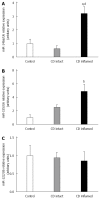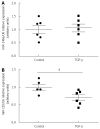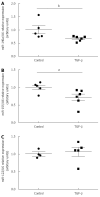Increased duodenal expression of miR-146a and -155 in pediatric Crohn's disease
- PMID: 27468194
- PMCID: PMC4948267
- DOI: 10.3748/wjg.v22.i26.6027
Increased duodenal expression of miR-146a and -155 in pediatric Crohn's disease
Abstract
Aim: To evaluate the role of microRNA (miR)-146a, -155 and -122 in the duodenal mucosa of pediatric patients with Crohn's disease (CD) and the effect of transforming growth factor-β (TGF-β) on these miRs in duodenal epithelial and fibroblast cells.
Methods: Formalin-fixed, paraffin-embedded biopsies derived from the macroscopically inflamed (CD inflamed: n = 10) and intact (CD intact: n = 10) duodenal mucosa of pediatric CD patients and control children (C: n = 10) were examined. Expression of miR-146a, -155 and -122 was determined by real-time polymerase-chain reaction (PCR). The expression of the above miRs was investigated in recombinant human TGF-β (1 nmol/L, 24 h) or vehicle treated small intestinal epithelial cells (CCL-241) and primary duodenal fibroblast cells derived from healthy children as well.
Results: Expression of miR-146a was significantly higher in the inflamed duodenal mucosa compared to the intact duodenal mucosa of children with CD (CD inflamed: 3.21 ± 0.50 vs CD intact: 0.62 ± 0.26, P ≤ 0.01) and to the control group (CD inflamed: 3.21 ± 0.50 vs C: 1.00 ± 0.33, P ≤ 0.05). The expression of miR-155 was significantly increased in the inflamed region of the duodenum compared to the control group (CD inflamed: 4.87 ± 1.02 vs
Control: 1.00 ± 0.40, P ≤ 0.001). The expression of miR-122 was unchanged in the inflamed or intact mucosa of CD patients compared to controls. TGF-β treatment significantly decreased the expression of miR-155 in small intestinal epithelial cells (TGF-β: 0.7 ± 0.083 vs
Control: 1 ± 0.09, P ≤ 0.05) and also the expression of miR-146a (TGF-β: 0.67 ± 0.04 vs
Control: 1 ± 0.15, P ≤ 0.01) and miR-155 (TGF-β: 0.72 ± 0.09 vs
Control: 1 ± 0.06, P ≤ 0.05) in primary duodenal fibroblasts compared to corresponding vehicle treated controls. TGF-β treatment did not influence the expression of miR-122.
Conclusion: The elevated expression of miR-146a and -155 in the inflamed duodenal mucosa of CD patients suggests the role of these miRs in the pathomechanism of inflammatory bowel disease. Anti-inflammatory TGF-β plays an important role in the regulation of the expression of these miRs.
Keywords: Crohn’s disease; Inflammatory bowel disease; MicroRNAs; Pediatric; Transforming growth factor-β.
Figures




Similar articles
-
Role of Altered Expression of miR-146a, miR-155, and miR-122 in Pediatric Patients with Inflammatory Bowel Disease.Inflamm Bowel Dis. 2016 Feb;22(2):327-35. doi: 10.1097/MIB.0000000000000687. Inflamm Bowel Dis. 2016. PMID: 26752469
-
Role of microRNA-223 in the regulation of poly(ADP-ribose) polymerase in pediatric patients with Crohn's disease.Scand J Gastroenterol. 2018 Sep;53(9):1066-1073. doi: 10.1080/00365521.2018.1498915. Epub 2018 Oct 9. Scand J Gastroenterol. 2018. PMID: 30299179
-
Altered mucosal expression of microRNAs in pediatric patients with inflammatory bowel disease.Dig Liver Dis. 2017 Apr;49(4):378-387. doi: 10.1016/j.dld.2016.12.022. Epub 2016 Dec 27. Dig Liver Dis. 2017. PMID: 28077249
-
MicroRNAs overexpressed in Crohn's disease and their interactions with mechanisms of epigenetic regulation explain novel aspects of Crohn's disease pathogenesis.Clin Epigenetics. 2021 Feb 18;13(1):39. doi: 10.1186/s13148-021-01022-8. Clin Epigenetics. 2021. PMID: 33602320 Free PMC article. Review.
-
Inflamm-aging microRNAs may integrate signals from food and gut microbiota by modulating common signalling pathways.Mech Ageing Dev. 2019 Sep;182:111127. doi: 10.1016/j.mad.2019.111127. Epub 2019 Aug 8. Mech Ageing Dev. 2019. PMID: 31401225 Review.
Cited by
-
The Contribution of Genetic and Epigenetic Factors: An Emerging Concept in the Assessment and Prognosis of Inflammatory Bowel Diseases.Int J Mol Sci. 2024 Aug 1;25(15):8420. doi: 10.3390/ijms25158420. Int J Mol Sci. 2024. PMID: 39125988 Free PMC article. Review.
-
miR-155 Predicts Long-Term Mortality in Critically Ill Patients Younger than 65 Years.Mediators Inflamm. 2019 Feb 24;2019:6714080. doi: 10.1155/2019/6714080. eCollection 2019. Mediators Inflamm. 2019. PMID: 30918471 Free PMC article.
-
Comprehensive Phenotyping in Inflammatory Bowel Disease: Search for Biomarker Algorithms in the Transkingdom Interactions Context.Microorganisms. 2022 Nov 4;10(11):2190. doi: 10.3390/microorganisms10112190. Microorganisms. 2022. PMID: 36363782 Free PMC article.
-
miRNAs Can Affect Intestinal Epithelial Barrier in Inflammatory Bowel Disease.Front Immunol. 2022 Apr 13;13:868229. doi: 10.3389/fimmu.2022.868229. eCollection 2022. Front Immunol. 2022. PMID: 35493445 Free PMC article. Review.
-
MicroRNAs in mucosal inflammation.J Mol Med (Berl). 2017 Sep;95(9):935-949. doi: 10.1007/s00109-017-1568-7. Epub 2017 Jul 20. J Mol Med (Berl). 2017. PMID: 28726085 Free PMC article. Review.
References
-
- Herfarth H, Rogler G. Inflammatory bowel disease. Endoscopy. 2005;37:42–47. - PubMed
-
- Oberhuber G, Hirsch M, Stolte M. High incidence of upper gastrointestinal tract involvement in Crohn’s disease. Virchows Arch. 1998;432:49–52. - PubMed
-
- Fujiya M, Sakatani A, Dokoshi T, Tanaka K, Ando K, Ueno N, Gotoh T, Kashima S, Tominaga M, Inaba Y, et al. A Bamboo Joint-Like Appearance is a Characteristic Finding in the Upper Gastrointestinal Tract of Crohn’s Disease Patients: A Case-Control Study. Medicine (Baltimore) 2015;94:e1500. - PMC - PubMed
-
- Magro F, Rodrigues-Pinto E, Coelho R, Andrade P, Santos-Antunes J, Lopes S, Camila-Dias C, Macedo G. Is it possible to change phenotype progression in Crohn’s disease in the era of immunomodulators? Predictive factors of phenotype progression. Am J Gastroenterol. 2014;109:1026–1036. - PubMed
-
- Béres NJ, Szabó D, Kocsis D, Szűcs D, Kiss Z, Müller KE, Lendvai G, Kiss A, Arató A, Sziksz E, et al. Role of Altered Expression of miR-146a, miR-155, and miR-122 in Pediatric Patients with Inflammatory Bowel Disease. Inflamm Bowel Dis. 2016;22:327–335. - PubMed
MeSH terms
Substances
Supplementary concepts
LinkOut - more resources
Full Text Sources
Other Literature Sources
Medical

